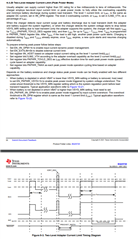Tool/software:
As we know,BQ25720 supports both IinDPM and Two-Level Adapter Input Current Limit(Peak Power Mode),so what‘s the difference and relationship between them?
If the IinDPM is set to 1A,and the ILIM1 in the feature of Two-Level Adapter Input Current Limit is also set to 1A,as the system overload comes to activate the IinDPM action,the ILIM2 in the feature of Two-Level Adapter Input Current Limit will never be hit actually due to the IinDPM operation preventing the input current increasing any more than 1A and hitting the ILIM2 value.
If my understanding above is correct,what’s the significance of the existing of ILIM2 and feature of Two-Level Adapter Input Current Limit (Peak Power Mode)?
As we know,IinDPM is designed to prevent adapter from overload,what‘s the design purpose of feature of Two-Level Adapter Input Current Limit?Why cannot IinDPM replace the feature of Two-Level Adapter Input Current Limit(Peak Power Mode)?


